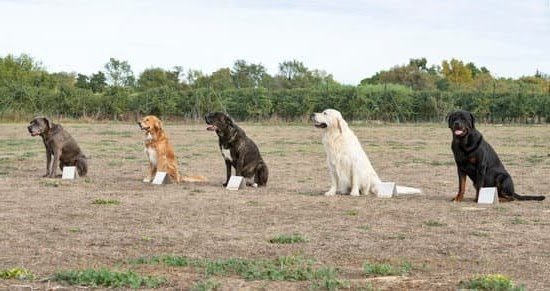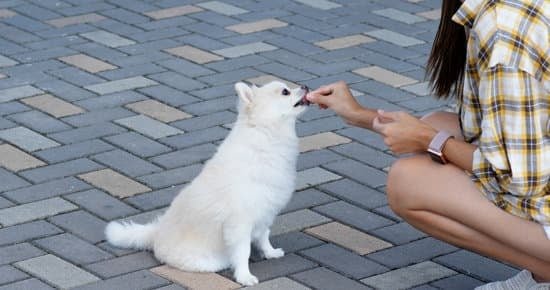Introduction
It is important to teach your dog to stay in the yard for both you and your pet’s safety. This skill can prevent them from wandering off, getting lost or being injured out of your care. Knowing where your pet is at all times can also provide peace of mind. Additionally, teaching a dog to stay in the yard will also ensure that they don’t escape into an unfamiliar area creating a risk for them or other people and animals in the neighborhood. Having control over your dog’s behavior means that you won’t have to worry about them running through areas where they could easily be injured, such as roads and busy sidewalks. Finally, by teaching this skill effectively, your dog will be less likely to bark excessively at passersby or pick up dangerous items like sticks, sharp objects and hot surfaces. Teaching your dog this command not only keeps them safe but gives you greater control in supervising their activities outside of the house.
Establishing the Best Environment for Training
Training a dog to stay in the yard requires making sure the environment is safe, distraction-free and comfortable. Ideally, when starting to train this behavior, an enclosed area like a fenced-in backyard will be used. Remove any distractions that could take away your dog’s attention such as bikes or other objects, as well as toys or food that may tempt them to wander off. Many pet owners find it helpful to keep their dogs on a leash at first until they begin to understand where the boundaries are with regards to staying in the yard. It’s also important for you and your pet to spend adequate time reinforcing this behavior step by step and providing ample rewards along the way. If there are treats available during training, keep them on hand and reward your pup for good behaviors continuously throughout the session. Once your pet starts getting closer and closer to mastering “stay” within the yard it may become necessary to increase his/her commit time gradually overtime so they can become accustomed to remaining in their designated area for longer periods of time. Working together with patience, consistency and plenty of positive reinforcement is essential when training a canine companion; hence the process might not be quick but if done correctly, desirable results should follow!
Supervising the Time in the Yard
When it comes to training a dog to stay in the yard, it is important to be active in supervising the time that the dog spends out there. Begin by setting aside regular time each day to take your dog outside and spend time with them while they are in the yard. Be sure to put up boundaries and ensure they are aware of their defined area. When they start to approach or cross those boundaries, give a simple command such as “Stay” or “Come Back” and provide positive reinforcement when they obey. You should also keep treats on hand as another reward for staying within their designated area. With consistent practice, your pup will soon learn to stay where you want them and understand the importance of keeping them safe in your home.
Exercising Essential Commands
Once you have successfully taught your dog the command “Sit”, you can move on to teaching him “Stay”. The stay command is a more advanced form of obedience training and requires patience and consistency. Start by standing in front of your pup and clearly say “stay.” Use hand signals such as wagging your finger or pointing outwards if necessary for extra clarity. It is important to remain calm and reinforce the desired behavior with treats or praise. Prepare several small treats for your pup so that each time he obeys the command you can reward him with a treat.
Start by having your pup stand in front of you and start off by maintaining close proximity, gradually taking steps away from them over time until he remains still no matter how far away from them you are. Every few seconds reward him with a treat when he does stay still. Practice increasing the length of time for him to stay still each session, beginning with about five seconds at first, then steadily progressing up to twenty seconds or more as his ability increases. If he moves before you give the release command, simply repeat the process using your verbal cues and hand signals again while staying positive throughout this process. Additionally, practice in different locations within the yard to ensure consistent results when trying various settings outside of just one designated spot during training sessions. By repeating these steps consistently over time and appropriately rewarding your canine companion for his good behavior, you should be able to effectively train him how to remain in your yard!
Techniques for Establishing Boundary and Staying Commands
Establishing a boundary and staying commands is not a difficult process but one that requires dedication and patience. When working with dogs for the first time it’s important to begin by establishing a well-defined boundary, such as a fence or some other type of physical obstruction that the dog can easily recognize as off limits. Begin teaching the stay command by standing a short distance away from the boundary and asking your pup to sit or lie down. Once your pup is sitting or lying down, hold out an open palm with your hand facing them while saying “stay”. Give verbal reinforcement each time they remain in their designated spot and reward them with treats when they have stayed for a few moments without moving. Once your pup has mastered these simple commands move away from the boundary towards what would normally be forbidden territory and repeat the stay command at slightly increasing distances until your pup exhibits full understanding of both boundaries and staying command. If at any point during training you detect signs of confusion or frustration take pause in reinforcing behavior until comprehension returns. Additionally, ensure that you offer ample breaks throughout training in order to keep their attention energetic and engaging. With practice and using these tips you should begin to notice success within several weeks of beginning training sessions.
Implementing Different Training Goals and Practices
It’s important to have specific training goals and practices in mind when teaching your dog to stay in the yard. First and foremost, you should have a clear boundary of what the dog is allowed to do within the confines of your yard. Make sure to mark this area off with a fence or other visual elements that the dog can understand, like signs or flags. Then, begin introducing basic commands such as “stay” and “come”. Start off with simple commands in a supervised manner so you can keep track of how well your pooch responds. As they start learning, gradually increase the challenge by having them stay further away from you for longer periods of time or going farther away from the boundaries of your yard before returning on command. Additionally, use positive reinforcement and rewards frequently throughout each training session. This will ensure that your pup associates staying within those boundaries with happy outcomes rather than any kind of punishment or negative response. With these steps, you’ll be able to train your pet effectively and help them adopt a safe behavior pattern inside their new boundary!
Rewarding and Praising Achievements
When training a dog to stay in the yard, setting expectations and rewarding successes is crucial. Dogs respond to rewards and praise when they accomplish a task. For example, if you want your dog to stay in the yard, each time it stays within the boundaries, praise and reward it with tasty treats or toys. This will reinforce positive behavior and help build trust in your relationship. Additionally, if possible, create a fenced –in area for your pup to roam. Keeping them in a visible space provokes awareness that they are being watched and less likely to wander away. Be patient when training your dog to remain within their designated space as it may take multiple attempts before they understand the desired behavior. But remain consistent each time by rewarding them for staying put so they never forget the importance of staying within their boundaries!
Anticipating Potential Issues and How to Handle Them
One issue that can often arise when training a dog to stay in their yard is that they may jump over the fence or dig underneath it. The best way to prevent this from happening is to make sure that the fence is as high and secure as possible. Additionally, keeping things like compost bins and other items away from the fence line will reduce any temptation they might have to dig escape routes or try and scale the fence.
Another issue can be surrounding distractions; particularly if your yard borders with streets or public areas. In these cases, it’s important to do some obedience training in order to teach your dog commands such as ‘sit’ and ‘stay’. Working on reinforcement through treats, toys and lots of praise for good behavior can also help ensure that your dog listens and stays in its yard even when faced with tempting distractions. It’s important to remember that all dogs are creatures of habit so consistency is key here.
Finally, if the yard has multiple entrances or exits it’s important to train your dog on how you’d like them to behave at each entrance/exit point e.g. waiting patiently at the gate until told otherwise. Keep in mind there might be more than one person wanting access at any one time; so practice with multiple people providing commands until your dog understands what behavior you expect near entrance/exit points.
Utilizing the Positive Reinforcement Method
The positive reinforcement method is a great way to train your dog to stay in the yard. The process starts with setting up boundaries and rules that you want your pup to follow. For example, set up an invisible fence or just establish where you don’t want your canine to go by planting shrubs or using visual barriers like gates and fences. Whenever your dog approaches the boundary, call it back to a safe place and reward it with treats or praise when it complies. It will take time, consistency, patience and lots of positive reinforcement, but soon your dog will come to understand its boundaries and respect them when they are reinforced. This is also a great opportunity to build trust between you and your four-legged friend while teaching them how to be well behaved in their home environment.
Tips and Tricks for Troubleshooting Training Struggles
When it comes to training a dog to stay in a yard, you need patience, persistence and consistency. Here are some tips and tricks for troubleshooting any training struggles that you may encounter.
1. Ensure your fence is up to the task: Before attempting any training, examine your chain-link or wooden fencing to make sure there are no weak points where your dog can escape from. Additionally, alter the landscape of your yard if necessary by adding low shrubs or bushes as an extra physical barrier against the fence line so your pup cannot clear or jump over them.
2. Make sure the boundaries are well defined: Take some time to physically walk around the perimeter of your yard with your pup following closely behind so he becomes familiar with his boundaries. You may also try using physical markers such as flags, ribbons or low fences built separately from the one enclosing your property that will help him better remember what areas he can go to and which ones he needs to avoid.
3. Invest in positive reinforcement training methods: Positive reinforcement is key in taming excitable dogs! Whenever your pup stays within bounds give him plenty of verbal praise coupled with treats to encourage him even further. Try repeating short commands such as “stay” when they settle in the area indicated while keeping contact through touch and verbal cues throughout their stay in order for them to fully understand what you expect of them each time they are allowed outside in their designated area during leash-free times.
4. Implement specific safety measures : If necessary invest into appropriate GPS trackers and lightweight fencing collars that’ll provide further security when letting them roam unsupervised near roads or busy streets filled with potential external dangers; these devices allow pet owners like yourself peace of mind knowing their pet will not wander off too far away from where one wants them most – inside their safe home grounds!
Conclusion
Now that you have successfully established basic boundaries and commands, your furry friend can safely stay in your yard! Spending time with your pup outside is a great way to bond. If your pet likes taking walks, consider getting a retractable leash for a bit more freedom exploring. And remember to reward your pup and give them lots of praise for their good behavior when they obey commands in the yard. With consistent reinforcement of these habits, you’ll likely find that it takes much less effort over time to keep your dog within the boundaries of the yard. Enjoy exploring the outdoors together and soaking up the fresh air!

Welcome to the blog! I am a professional dog trainer and have been working with dogs for many years. In this blog, I will be discussing various topics related to dog training, including tips, tricks, and advice. I hope you find this information helpful and informative. Thanks for reading!





